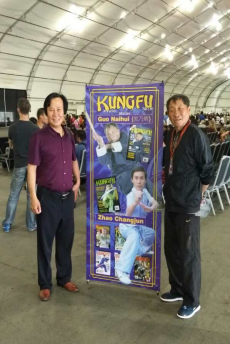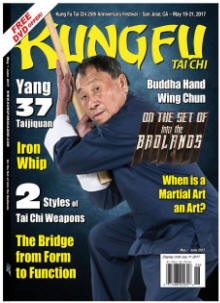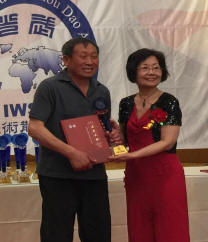A Cultivated Master of Many Arts
Master Guo Naihui (郭乃辉) is a proponent of several traditional Kung Fu styles, but the most interesting are his esoteric ones, his outliers. He is the last of his generation to be a master of a very unique weapon, Biangan. He is also a representative of a Muslim fusion style known confusingly enough as Tongbei, because it is completely different from the Tongbei most Kung Fu people think it is. These are complex and sophisticated styles – uncommon arts in the martial arts – so it requires some hard work to get at the story behind them. But first, some background on Master Guo.
Guo is a native of Dongbei, or the Northeast of China, a region once dubbed Manchuria by the Japanese. This area encompasses three provinces; Guo was from Liaoning Province. In 1958, at age three, his family moved to Jiayuguan City in Gansu Province. Jiayu Pass is guarded by a large still-intact fortress, part of the Great Wall. There, at age twelve, Guo began his martial journey, studying Shaolin Kung Fu with his brother. He eventually found a Shaolin master named Li Zhenxi (李振喜) and became proficient enough under him to earn acceptance to the illustrious Beijing Sports University in 1975. That was a year after the Beijing Wushu Team was founded there by Wu Bin (吴彬) and Li Junfeng (李俊峰). It was the birthplace of Modern Wushu, when the infant sport was still intimately connected to its martial roots. Guo was coached by Gan Guizhang (阚桂香) and learned the original compulsory competition forms. After he graduated in 1978, Guo was sent back to Gansu to disseminate the Modern Wushu program. He was sent to teach Wushu at the Gansu Sheng Tiyu Yundong Xuexiao (甘肃省体育运动学校).
However, Guo's foray into the sport of Modern Wushu did not curtail his passion for the traditional arts. He became a disciple of Grandmaster Ma Yingda (马穎達). Ma is in the bloodline of one of the most powerful martial clans in China. He is the son of Ma Fengtu (马凤图), an influential grandmaster who fathered three other sons, each a grandmaster in his own right. The three other brothers include Ma Xianda (马賢達), one of the very first grandmasters to be certified with China's highest martial rank of 9th duan (level 段), Ma Mingda (马明達), a leading martial professor at the Jinan University in Guangdong Province, and Ma Lingda (马令達) who represents the family in Lanzhou City, also in Gansu.
The Ma family are Chinese Muslims. With the national concern over Muslims in America, it is important to remember that not all Muslims are from the Middle East. Islam has been in China for 1400 years, same as Christianity. Both came to China via the Silk Road during the Tang Dynasty (618–907 CE). There are discrepancies over the Muslim population in China today. The third and fourth largest ethnic minorities in China are Islamic. The Uyghur had an estimated population of 15 million two years ago. The Hui were estimated at 10.5 million in 2011. Additional Chinese minorities have Islamic leanings so the entire population is unclear.
Chinese Muslims have had a profound influence on the martial arts. Two prominent Kung Fu styles are credited to Muslim factions: Tantui (springing leg彈腿), considered the foundation of Northern Style Kung Fu (more on this later), and Chaquan (literally "seeking fist" 查拳), a long-fist style that was one of the building blocks of Modern Wushu. The bulk of China’s Muslim population resides in the Northwest in a region dubbed “the Quran Belt,” specifically the provinces of Xinjiang, Ningxia, Qinghai and Gansu. Master Guo, Ma Yingda and Ma Lingda were all in Gansu.
Biangan – the Short Stick
Biangan (鞭杆) is a short stick, although the characters that comprise the name are a little confusing. Bian literally means "whip," although it can also refer to a string of firecrackers. It is the same word used for chain whips as well as a less common Chinese weapon, a "hard" whip. A hard whip is a metal truncheon with a hilt like a sword. Usually hard whip shafts are knurled like bamboo. Gan means a pole, specifically the shaft of a spear. The Biangan that Master Guo uses is a straight pole. It’s longer that a typical baton or Escrima stick (about two feet) and longer than most one-handed swords (about three feet). But it’s shorter than a typical Kung Fu staff, which is usually about the height of the user’s eyebrow or, for the tapering "rat-tail" style of staff, the height of the user’s hand with arm raised overhead. The Biangan is an unusual height for a Kung Fu staff, but versatile because it can be used like a staff or a two-handed sword.
According to Master Guo, the Biangan is a Gansu folk art that descended from applications of the equestrian riding crop. He also points to a seminal Ming Dynasty martial writer, Cheng Zhongyou (程宗猷 1561–? CE), also known as Chen Chongdou (陈沖斗). He wrote a treatise titled, Single Saber Method (Dandao fa xuan 单刀法选), which outlined eighteen movements of two-handed single-edged saber. Accordingly, this sword is more like a Japanese katana than a conventional Chinese dao. This sword is commonly called a miaodao (literally "sprout blade" 苗刀), although some argue it is an erroneous label. They claim the name miao comes from China's fifth largest ethnic minority, the Miao, as they use a sword with a similar design, and that this is not connected to Cheng’s Dandao. Arguments aside, Single Saber Method was a pivotal work, as it allegedly elucidated techniques derived from Japanese swordsmanship that were critical in the defeat of Japanese pirates, a.k.a. Wokuo (倭寇), during the Ming period. This was a significant battle in Kung Fu history, as the Shaolin monks are credited as one of the many groups that helped China secure her borders against the Wokuo. Perhaps not coincidentally, Cheng also wrote Shaolin Staff Method (Shaolin gunfa chanzong少林棍法闡宗), which is one of the earliest manuals to attribute staff fighting to the Shaolin school (more on this later too). And an additional perhaps-not-coincidental footnote, Cheng’s nephew Cheng Ziyi (程子頤) wrote Outline of Martial Preparedness (Wu bei yao lue武备要略), which included a section on Bian largely derivative of Cheng’s two-handed Dandao techniques.
Master Guo’s Biangan has three main forms: Yellow Dragon Biangan (huanglong biangan黄龙鞭杆), Dropping Hand Biangan (diaoshou biangan掉手鞭杆) and Bind the Sea Eighteen Strikes Biangan (chanhai shiba da biangan 缠海十八打鞭杆). Additionally, there are three more sequences for training which aren’t quite stand-alone forms but are part of the curriculum. These are Five Yin Biangan (wuyin biangan 五阴鞭杆), Seven Hand Biangan (qishou biangan 七手鞭杆) and Thirteen Techniques Biangan (shisan fa biangan 十三法鞭杆).
Tongbei – Not "Through the Back"
Being a disciple of Grandmaster Ma Yingda, Master Guo was indoctrinated into the family’s distinctive Kung Fu style of Ma Clan Tongbei (Ma shi tongbei 马氏通备). Tongbeiquan (Through the Back Fist 通背拳) is a popular Northern style of long-fist Kung Fu. It is characterized by long swinging arm movements and self-slapping. However, this is not what the Ma Clan espouses. Take careful note of the "bei" character. In Tongbeiquan, it is the character for "back (背)." In Ma Clan Tongbei, it is a homophonic character (备) that means "prepare," "ready" or "perfect." It’s the same "bei" as in the title of Cheng Ziyi’s Outline of Martial Preparedness. This has muddled discussions of the style in English where the Chinese characters are not used, as many have mistaken Ma Clan Tongbei for Tongbeiquan.
Ma Clan Tongbei fuses four Kung Fu styles: Piguaquan (split hanging fist 劈掛拳), Bajiquan (eight extremities fist 八極拳), Fanziquan (rotating fist 翻子拳), and Chuojiao (feet poking 戳腳). Pigua is another Northern long-fist style characterized by wide circular movements and long-range attacks. It is often coupled with Baji as a complimentary practice. Baji is sometimes categorized as an internal style; it relies upon explosive elbow and shoulder strikes and penetrating hip checks. Fanzi and Chuojiao are often coupled too. Both styles are apocryphally attributed as the creations of Song Dynasty hero General Yue Fei (1103–1142 岳飞). Fanzi is famous for its fast hand techniques and is a contributing foundation style for Eagle Claw Kung Fu. As the name implies, Choujiao emphasizes kicking and leg techniques. It has a vast array of unconventional kicking methods.
Master Wu says that in addition to elements of these four styles, Ma Clan Tongbei has a complete arsenal of traditional weapons. The primary staff form is Wind Demon Staff (Feng mo gun 风魔棍), which is based on the fifty-five stances and techniques of Cheng Zhongyou’s Shaolin Staff Method. It also has many sword forms. For single-edged swords, it has Pigua Dao (劈挂刀), Piaoyao Dao (fast elegant blade 骠姚刀), Pofeng Dao (break spear point blade破锋刀), Luhe Dao (join army blade 陆合刀) and several others. It also has a large single-edged sword known as Tongbei Dadao (通备大剑). The double-edged straight swords (jian 剑) of Tongbei are mostly wielded with both single- and double-handed methods. These are for larger jian, what western swordsmen might call "hand-and-a-half swords." Tongbei Big Sword (Tongbei dajian 通备大剑) is also called 73 Sword (qishisan jian 七十三剑) or Proclaim Change Sword (xuanhua jian 宣化剑). There is also a small sword called Silk Robe Sword (tipao jian 绨袍剑). For spears, it has Six Harmony Spear (liuhe qiang 六合槍) and Qi Spear (Qi qiang 戚槍), named after the imminent martial scholar Qi Jiguang (1528–1588 戚继光). Beyond the standard four weapons, Tongbei also has other classical weapons common to Kung Fu like three-section staffs (sanjie gun 三節棍).
Chuojiao – Poking Feet
Master Guo estimates that Tongbei has some forty or fifty empty-hand forms based on the four aforementioned styles. Additionally, there is a 108 movement health cultivating form which Guo says is akin to Taiji called Tongbei Big Clan (Tongbei dajia 通备大家). Most pupils learn all of the hand forms and, accordingly, learn the quintessence of the quartet of traditional styles upon which Tongbei is based. While each of these styles are worthy of further analysis, for the sake of brevity, the remainder of this article will focus on Chuojiao. Master Guo has a deeper connection to Chuojiao because one of the major branches of the style came through the Duan Clan (段). The Duan Clan were from Hebei Province, which Guo’s blood grandparents called home.
Guo says that Chuojiao predominantly deploys kicks using the ball of the foot. These kicks seldom aim at targets above waist level. For the uninitiated, Chuojiao kicks are decidedly weird. They attack from surprising directions to strike the ankle, knee and groin. Tantui is considered by many to be the root of Northern kicking power, but Master Guo disagrees. “Tantui is the basics (jibengong 基本功) for Chuojiao,” states Guo in Mandarin. “When people say 'Southern fists, Northern legs (nan quan bei tui 南拳北腿),' the legs are actually Chuojiao, not Tantui.” Guo doesn’t say this to denigrate Tantui. It's a style he holds in high regard. In the late nineties, Guo also served as a professional Taekwondo coach in China. Taekwondo became an Olympic demonstration event in 1988 and was on the path to becoming an official medal event in 2000, so China prepared athletes, and Guo’s kicking expertise positioned him to be a coach. The shift of style didn’t bother him at all. “All the Taekwondo kicks are in Tantui,” he says.
Master Guo is quick to point out that Ma Clan Tongbei is a fighting style. Practitioners box, kickbox and spar with short weapons as a regular part of training. Guo says that Chuojiao also has a specialized striking dummy. He describes it as a springy rod of human height, set at an angle with a thick base. He says it is used to train kicking powerfully and fleeing quickly. Nowadays, it isn’t used very much. In China, they practice on old tires, although he’s seen them in Russia where he travels often to teach. There are many Ma Clan Tongbei branches in Russia and Japan. Despite its effectiveness, Chuojiao is rare today. “The teachers were too conservative in the old days,” sighs Guo. “Many masters of Chuojiao only have one road.”
Art for Art’s Sake
To the uninitiated and uneducated, such longwinded explanations are overwhelming and tiresome. In the era of tweet-shortened attention spans, it’s too much work to try to understand all this complicated talk. It’s easier to write it all off to the waxing of elitist masters. After all, how does all this background knowledge really help in a fight?
But if the martial arts want to claim to be "art," this knowledge is indispensable. Cultural context is what frames art. The Ma family are stalwart keepers of the traditional art of Kung Fu, and as Ma Yingda's disciple, Master Guo inherited much of the clan's extraordinary legacy. No matter how hard it is to learn, how hard it is to understand, and how hard it is to pass down, it is exactly this hard work that makes it real Kung Fu.
http://www.kungfumagazine.com/magazine/article.php?article=1354


